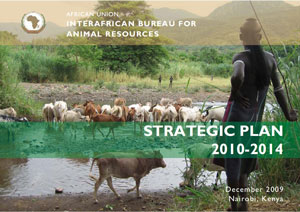AU-IBAR Strategic Plan 2010-2014
The Strategic Plan was developed through a process that spanned most of 2009. Although the strategic planning process was facilitated by external consultants, its content is entirely based upon the ideas and material generated during the highly participatory and broadly-based strategic planning process. AU-IBAR’s Strategic Plan 2010-2014, therefore, both belongs to and was co-created by its managers, staff, key clients and stakeholders.
Trends, drivers, challenges and opportunities for the African animal resources sector

AU-IBAR’s Strategic Plan must be responsive to changes both in the African landscape and on the international scene. Key trends and drivers were therefore identified that are relevant to the African animal resources sector and provide the background and rationale for the identification of AU-IBAR’s strategic programmes.
The key trends and drivers identified included: the threats and opportunities represented by globalization; the latent potential of the Livestock Revolution for African livestock producers; hurdles to greater market access; the potential role of livestock in a generally hotter, drier continent balanced against their contribution to climate change through greenhouse gas production; the changing dynamics of animal diseases and the emergence and re-emergence of diseases, especially zoonoses; renewed interest in agriculture as a tool for poverty reduction and economic development; the emergence of new players and institutional arrangements relevant to the sector; a shift in policy making to increasingly place poverty reduction at the centre of the development agenda; recognition of the constraints women face in livestock production; rapid developments in the fields of information and communication technologies, especially massively increased access to mobile phones, and the potential of biotechnology; and the vulnerability of the poor to instability, natural disasters, diseases, conflicts and uncertainty about access to both resources and markets, often without recourse to adequate means to manage these risks.
vision, mission, mandate, core values and strategic niche
As part of the strategic planning process, AU-IBAR revisited its vision, mission and mandate. From this process emerged a new set of statements that better frame and serve the new paradigm:
Vision: An Africa in which animal resources contribute significantly to the reduction of poverty and hunger.
Mission: To provide leadership in the development of animal resources for Africa through supporting and empowering AU Member States and Regional Economic Communities.
Mandate: To support and coordinate the utilization of animals (livestock, fisheries and wildlife) as a resource for human wellbeing in the Member States of the African Union and to contribute to economic development. The specific areas of the mandate are to:
1. Improve public and animal health through the control and possible eradication of transboundary animal diseases and zoonoses;Improve the management of animal resources and the natural
2. resource bases on which they depend;
3. Explore investment options and enhance competitiveness of 3. African animal products;
4. Contribute to the development of relevant standards and 4. regulations and enhance compliance by Member States
5. Strengthen institutional capacity and support policy development 5. and harmonization;
6. Disseminate information and knowledge on animal resources 6. to Member States, Regional Economic Communities and other relevant institutions; and
7. Provide essential support to Member States with special needs 7. or in emergency situations.
